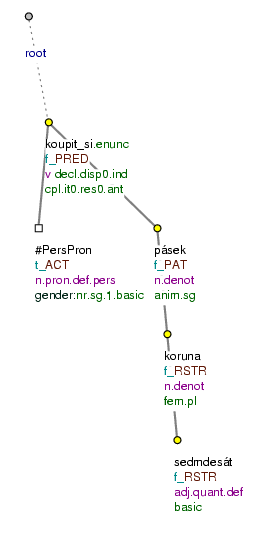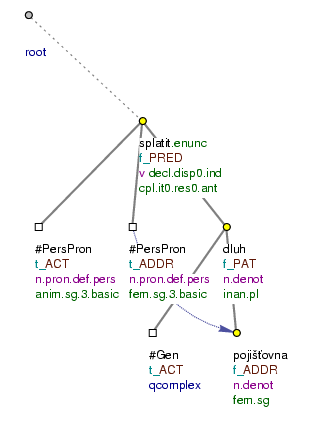In those structures in which a modification has a dual (or multiple) function (i.e. it modifies several elements at the same time but it is expressed only once for stylistic or other reasons), such a modification depends on the node representing the lowest potentially modified element and it is assigned a functor that corresponds to its actual position. There is no explicit indication that the modification has a dual function. Cf.:
-
Koupila jsem si pásek za sedmdesát korun (=lit. (I) bought - myself (a) belt for seventy crowns.).
= Koupila jsem si za sedmdesát korun .
MEANSpásek za sedmdesát korun.RSTR(=lit. (I) bought - myself for seventy crowns (a) belt for seventy crowns.)The modification za sedmdesát korun (=lit. for seventy crowns) modifies both the verb koupit (=to_buy) and the noun pásek (=belt). In the tree this modification is represented lower in the structure, i.e. as dependent on the noun pásek (=belt), and it is assigned the functor
RSTR. Cf. Fig. 6.187. -
Koupil boty pro kluka (=lit. (He) bought shoes for (a) boy.).
= Koupil pro kluka.
RSTRboty pro kluka.ADDR(=lit. (He) bought for (the) boy shoes for (a) boy.)The modification pro kluka (=for a boy) modifies both the verb koupit (=to_buy) and the noun boty (=shoes). In the tree this modification is represented lower in the structure, i.e. as dependent on the noun boty (=shoes), and it is assigned the functor
RSTR. The Addressee of the verb koupit (=to_buy) is optional. No new node for this Addressee will be added to the tree (see also Section 2.4.1, "General arguments and unspecified Actors").
It is necessary to distinguish modifications with a dual function and modifications without a dual function. Cf.:
-
Koupila jsem si pásek za sedmdesát korun (jen za padesát) (=lit. (I) bought - myself (a) belt for seventy crowns (for only fifty -).
-
Koupil boty pro kluka (a dal je své dceři) (=lit. (He) bought shoes for (a) boy (and gave them (to) his daughter)).
A modification with a dual function can represent a valency modification of one or both of its governing elements. In such a case it is also represented at the lowest possible position in the structure. If a valency modification is missing, then, a newly established node with the t-lemma substitute #PersPron is added to the tree and the (textual) coreference relation to the modification present in the surface structure is marked in the tree (see also Section 3, "Textual coreference"). Cf.:
-
Splatil dluhy pojišťovně (=lit. (He) paid_off (his) debts (to) (the) insurance_company.).
= Splatil pojišťovně.
ADDRdluhy pojišťovně.ADDR(=lit. (He) paid_off (to) (the) insurance company (his) debts (to) (the) insurance_company.)The modification pojišťovně (=(to) (the) insurance_company) modifies both the verb splatit (=to_pay_off) and the noun dluhy (=debts). In the tree it will be represented lower in the structure, i.e. as dependent on the node representing the noun dluhy (=debts). The missing Addressee of the verb splatit (=to_pay_off) is substituted by a newly established node with the t-lemma substitute
#PersPronand the (textual) coreference relation to the modification to the insurance company present in the surface structure is marked in the tree. Cf.: Fig. 6.188.
Figure 6.187. Dual function of a single modification

Koupila jsem si pásek za sedmdesát korun (=lit. (I) bought - myself (a) belt for seventy crowns.)
Figure 6.188. Dual function of a single modification

Splatil dluhy pojišťovně (=lit. (He) paid_off (his) debts (to) (the) insurance_company.)
For details on a dual function of valency modifications of complex predicates see Section 9.3.4.1, "Dual function of a valency modification of the complex predicate".